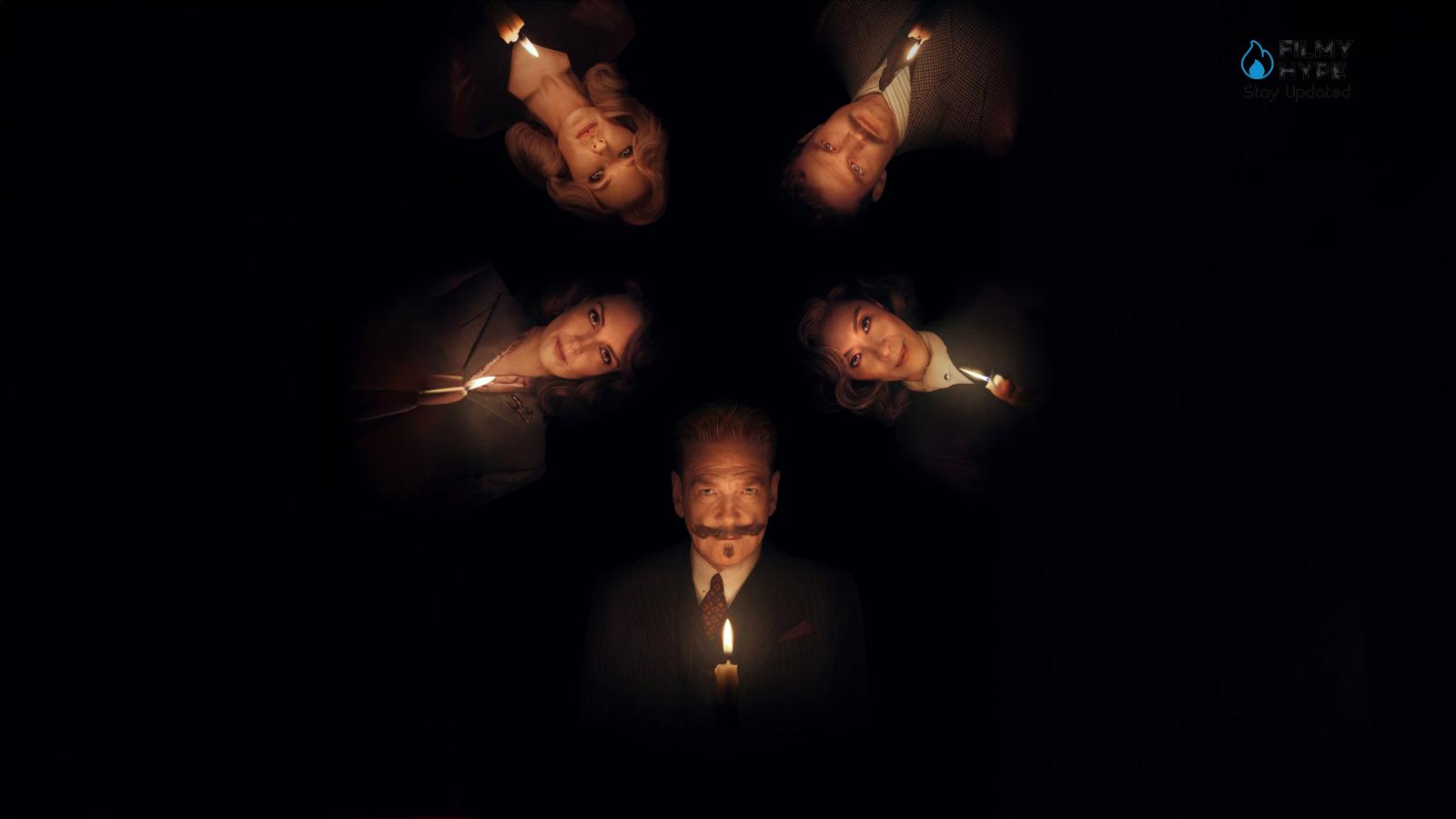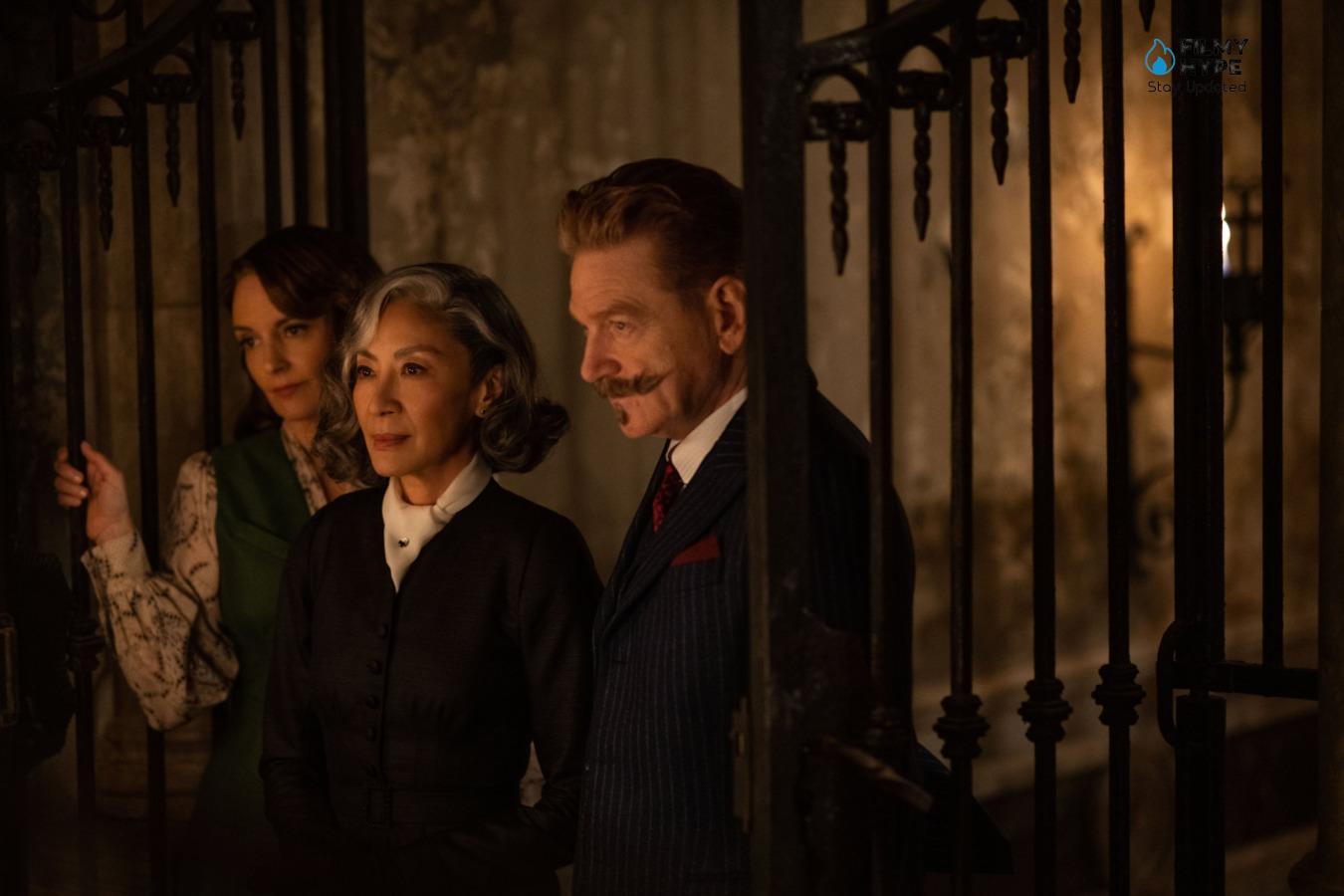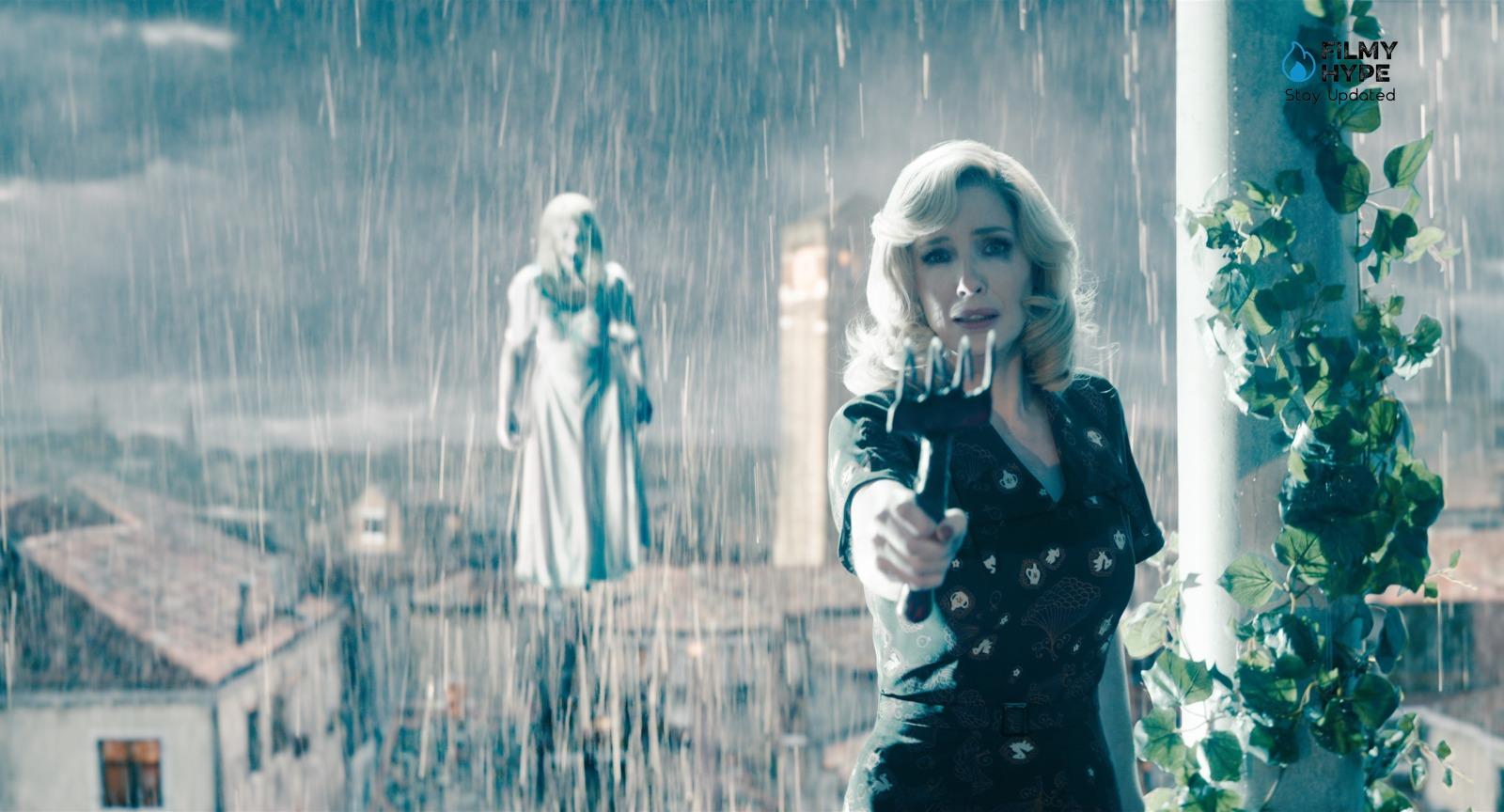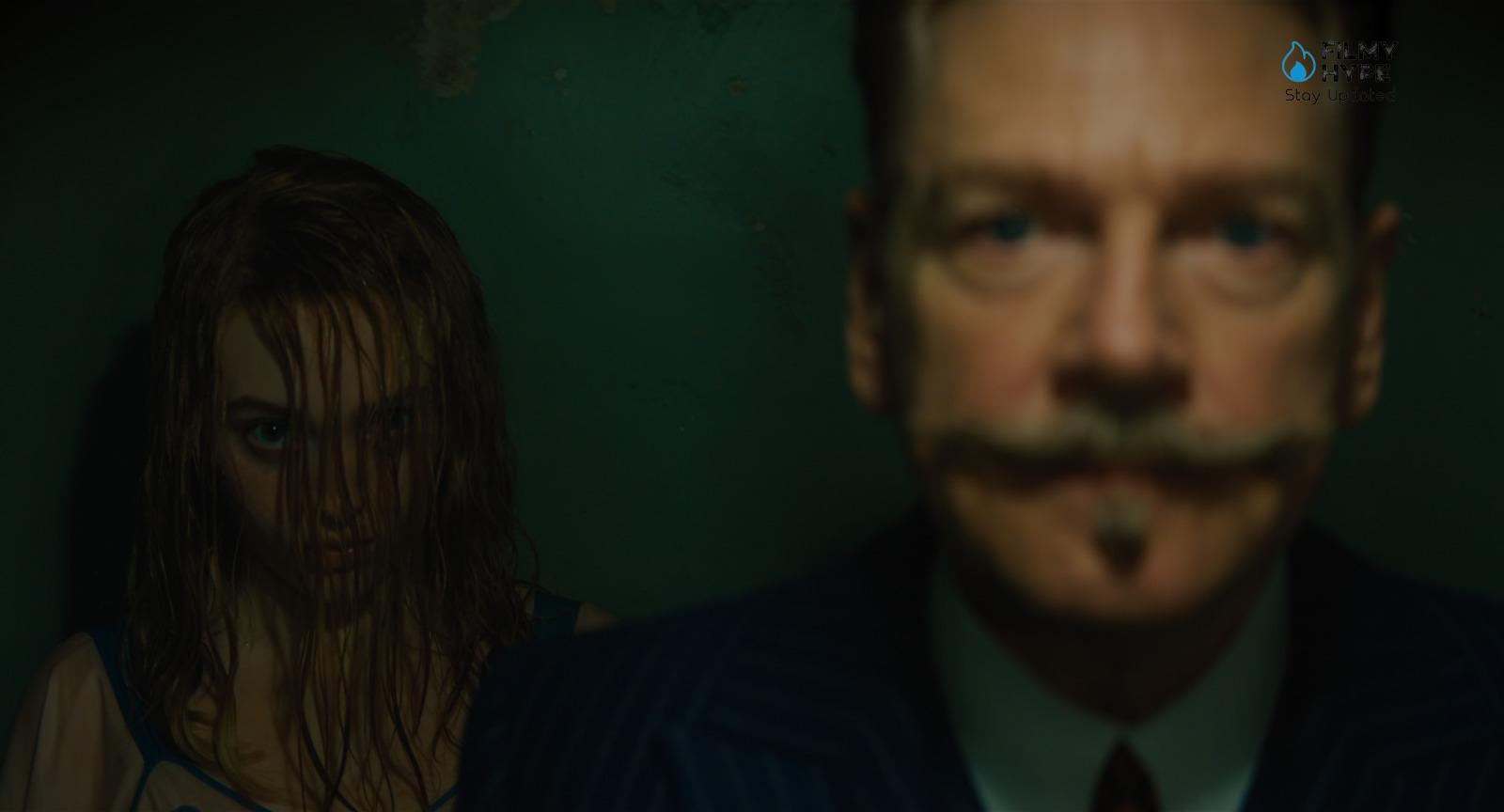A Haunting in Venice Review: Kenneth Branagh’s Poirot in a Darkly Colored Mystery
Cast: Kenneth Branagh, Kyle Allen, Camille Cottin, Jamie Dornan, Tina Fey, Jude Hill, Ali Khan, Emma Laird, Kelly Reilly, Riccardo Scamarcio, Michelle Yeoh
Director: Kenneth Branagh
Filmyhype.com Ratings: 3.5/5 (three and a half stars) [yasr_overall_rating size=”large”]
Based on Agatha Christie’s detective novel Hallowe’en Party, from 1969, Kenneth Branagh’s A Haunting in Venice chooses to draw its origins from a literary material full of meaning, and then rework it into a cinematic detective story with dark hues and exquisitely noir charm. Unlike the original paper version, where everything comes to life in the city of Venice, in a lagoon context that speaks its language, parallel to that of the plot, exposing the uncertainties of the protagonists with glimpses that seem frozen in time, details deeply torn by the incessant passing of the eras and a certain authorial attitude that is intangible and perfectly coherent with what happens on the screen. The third film of the saga. Third attempt for Kenneth Branagh in the double role of director and leading actor.

After Murder on the Orient Express and the disastrous Death on the Nile, A Haunting in Venice has the task of reviving the fortunes of detective Hercule Poirot. Hercule Poirot returns to the scene conveying a series of reflections which, although starting from the dimension of mystery and detective stories, have no difficulty in landing among the slimy shadows and uncertainties of noir, touching without hesitation on the darkest horror that exists that of pain human and insurmountable trauma, torment and uncertainty towards oneself and towards what one has always believed in. Arriving in Italian cinemas on 14 September 2023, A Haunting in Venice confirms Branagh’s touch and his particular attention to the specific human, staging a story that spares no one.
A Haunting in Venice Review: The Story Plot
Venice, 1947. Poirot (Kenneth Branagh) has chosen the Lagoon as his retreat after the end of the Second World War. The war conflict has left him disillusioned and embittered, so much so that he has locked himself in his golden Venetian prison, without accepting cases and without wanting to meet anyone, with only his bodyguard Vitale Portfoglio (Riccardo Scamarcio) at his side to shield him from the demands of the world external. However, the writer Ariadne Oliver (Tina Fey) manages to intrigue Poirot, asking for his help in disguising a medium named Joyce Reynolds (Michelle Yeoh) on the eve of a séance. The woman will try to evoke the spirit of the deceased daughter of the soprano singer Rowena Drake (Kelly Reilly), the inconsolable owner of the Palazzo delle Lacrime in Venice. On Halloween night Ariadne and Poirot will participate in the session, as skeptics determined to unmask the scammer. They will find themselves facing a macabre murder that seems somehow linked to the death of Rowena’s daughter. Is there a murderer among the guests or are the spirits of the children who haunt the cursed house the ones who killed?
A Haunting in Venice Review and Analysis
The opening of A Haunting in Venice is extremely classic, presenting Hercule Poirot (played by Kenneth Branagh himself) intent on enjoying a peaceful retreat from the world of investigation and crime. His life proceeds in total tranquility, framed by a Venice that is both very close to the spectators and distant, the story is set at the end of the 40s, after the Second World War. The existential routine of the legendary investigator, however, is about to be teased by a mystery given to him by a dear and old friend of his, Ariadne Oliver (Tina Fey), interested in clarifying the skills of a medium, Joyce Reynolds (Michelle Yeoh), who seems to be becoming popular with her incredibly real numbers. Intrigued by Ariadne’s words, Poirot, doubtful, abandons his exile to join the séance organized by Rowena Drake (Kelly Reilly) in a famous Venetian house, famous for some terrible crimes that occurred inside it.

On site with him are a handful of characters all connected by a very thin red thread made of memories, pain, and a corpse on their conscience that has always tormented them. When the situation takes a bloody turn, the great investigator can’t help but get back into action, driven by a curiosity rooted deep in his mind. Thus, a case full of emotionally uncertain elements comes to life before everyone’s eyes, engaging the human sphere in that of spiritual and personal doubt. A Haunting in Venice is by no means an easy film, committing itself from the beginning to building an extremely multifaceted narrative that continually plays with both the spectators and the characters at play. At the center of everything, even before the story, we find a visceral and dark Venice, darkly square and isolating. Kenneth Branagh immediately undertakes to frame it in the best possible way, alternating extremely geometric and nostalgic images, with camera movements that accentuate, together with the editing, the frightening artistic coldness of some typical decorations of the lagoon city.
This figurative game further enriches the identity of a film intent on contaminating the crime genre with that of noir and introspective horror, modeling on the psyche of the protagonists the same shapes and shadows that surround them from sequence to sequence. The underlying mystery is clearer than ever: a girl has previously committed suicide and her mother wants answers on the matter through the use of a famous medium. Questions, however, are a must, especially when the occult becomes both a narrative means and a tool through which to undermine the certainties of all the protagonists involved, Poirot included. Assassination in Venice soon draws from the popular and horrifying background dimension to build a case full of question marks seemingly impossible to justify and resolve. Everything is accentuated by very dark photography (edited by Haris Zambarloukos) and by a humid and wet staging, almost enough to feel it on you.

Together with the facts narrated, it is the sets that speak the language of personal fear and dread, further accentuating what the characters feel and helping to convey an almost continuous sense of claustrophobia, fundamental in the very identity of the images that make up the whole thing. In this way A Haunting in Venice manages to overcome its limits, immersing itself in shadows and doubts that torment both Poirot himself and the spectators concentrated on trying to understand what is happening on the screen. This is certainly the film’s greatest merit, that of being able to immediately involve you in the events covered, despite it being a story which, at least in appearance, presents a series of very classic models and stylistic features. Thus, from an inconclusive case, we find ourselves involved in an extremely unpredictable context in which the dimension of profound terror continually plays with crime and a mystery with complex features.
Unlike in the past, in A Haunting in Venice Kenneth Branagh decides to build a case by reworking it under the shadow of the occult, and repeatedly citing the style of a writer of the caliber of Edgar Allan Poe. The mix of indecipherable horror and human and terrible mystery is the main driving force of a mannered cinematic mystery, with both classic and psychologically profound shades. Everything is packaged with a refined direction that tries to directly involve the spectators in the room, putting them in a position to experience almost the same sensations as the protagonists, working on direct involvement in a figurative sense. In addition to the aesthetic dimension, A Haunting in Venice presents itself first and foremost as a study of human suffering, of the deep and hidden pain that it is possible to drag behind and within oneself, hiding it from prying eyes, and then explode with a dispersive and desperate, humid, alienating and profoundly wild. Everything is silent deep down in this film, everything lies in the unsaid and in what we prefer to hide and fight without attracting too much attention.
Net of some predictable forcing (Halloween celebrations in Venice?), the choice to move the setting of Poirot and the Massacre of the Innocents turns out to be sensible: the nocturnal atmospheres of the lagoon city have a sulfurous patina that goes very well with the tone of the film. Kenneth Branagh and screenwriter Michael Green propose a very free adaptation of Agatha Christie’s novel, also because this version of the detective now belongs more to Hollywood than to the English writer. Nonetheless, the action nuances of the previous films give way to a more classic setting, faithful to the rules of the whodunit: the investigation of Poirot unfolds gradually through the interrogations of the characters, who thus reveal their pasts and possible motives. A somewhat rigid and repetitive structure, but consistent with the mystery tradition, and free of fights or chases. Violence always remains out of the picture.

A Haunting in Venice trades adventure for horror and allows Branagh to enhance his characteristic Dutch shots, The crooked shots he is crazy about the effect evoke a distorted reality, closer to ‘nightmare than reality. It is no coincidence that the film works a lot on editing and sound effects (abrupt and sudden noises, thuds, slamming windows, animal sounds) to offer a good dose of jump scares, conveying the idea of a threat that can strike at any time. The unity of location also helps, as it is much more precise than in previous films, which were somehow always in motion. If we exclude the prologue, the action takes place entirely in the palace during a storm, fueling the isolation and frustration of potential victims.
The limit, if anything, lies precisely in the plot: the resolution of the mystery has very little that is surprising, and is less complex than in the past, also because it relies on an already known narrative tops. More than in the plot itself, the heart of A Haunting in Venice beats in the gloomy atmospheres, in the waits between one turning point in the story and another, and this differentiates it greatly from its predecessors. It’s a shame that continuity with Murder on the Nile is almost absent, considering the epilogue of the latter and its importance in Poirot’s life. On the other hand, his adventures are enriched with new supporting characters: fans, in particular, will be happy to see Tina Fey’s Ariadne Oliver, also because the former author of Saturday Night Live perfectly conveys the arrogance and sarcasm of the mystery writer. She and Poirot are engaged in an investigation that calls into question their own beliefs, but the film – unlike Christie’s books – adopts an ambiguous position on the supernatural: as often happens in Hollywood, the otherworldly seems to be the only way to make sense of the world.
A Haunting in Venice Review: The Last Words
A Haunting in Venice is a dark and deeply human film. In narrating the pain of a loss, he involves his audience in a case in which real physical violence goes beyond the limits of the act itself, touching the most intimate chords of the characters in the play. Kenneth Branagh creates a film studied from an aesthetic and figurative point of view, constantly fueling a game of shadows and questions that go beyond the cinema screen, invading the room without too much difficulty. The result? A mystery that is not just a mystery, a mystery that uses the terrors of the occult to hide its true nature to the core, until the last possible moment.
A Haunting in Venice Review: Kenneth Branagh's Poirot in a Darkly Colored Mystery | Filmyhype

Director: Kenneth Branagh
Date Created: 2023-09-15 17:05
3.5
Pros
- The entire cast is perfectly in place.
- Venice chosen as the backdrop and location of the film lends itself perfectly, immediately becoming the direct mirror of the action and mystery in progress. All with wonderful scenery.
- Hercule Poirot and his undeniable charm are still intact today.
- A direction that knows perfectly how to connect with the material covered, refining it.
Cons
- Some stereotypes and moments not too in-depth, but left to the momentary interpretation of the actors or without any response.
- There is very little CGI, but what there is isn't very convincing.




